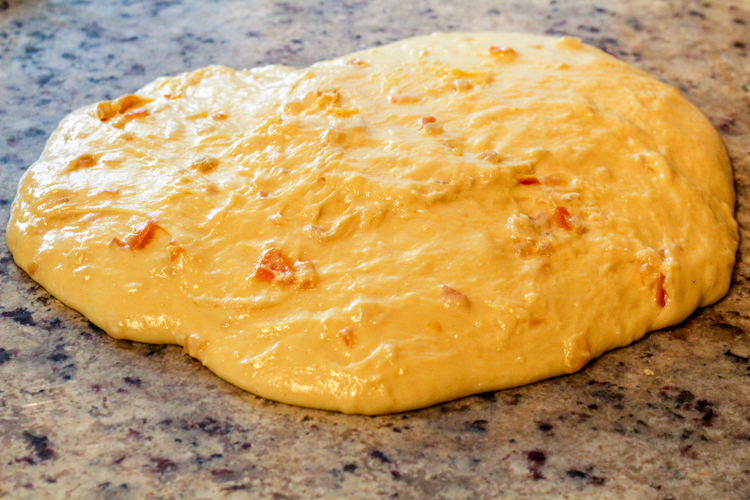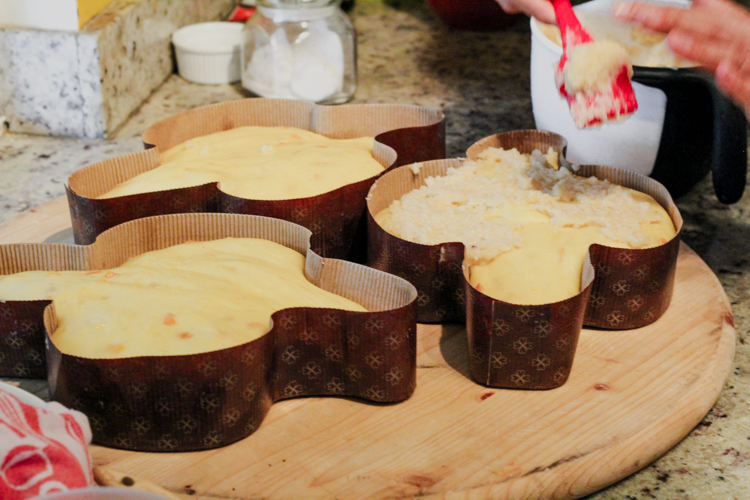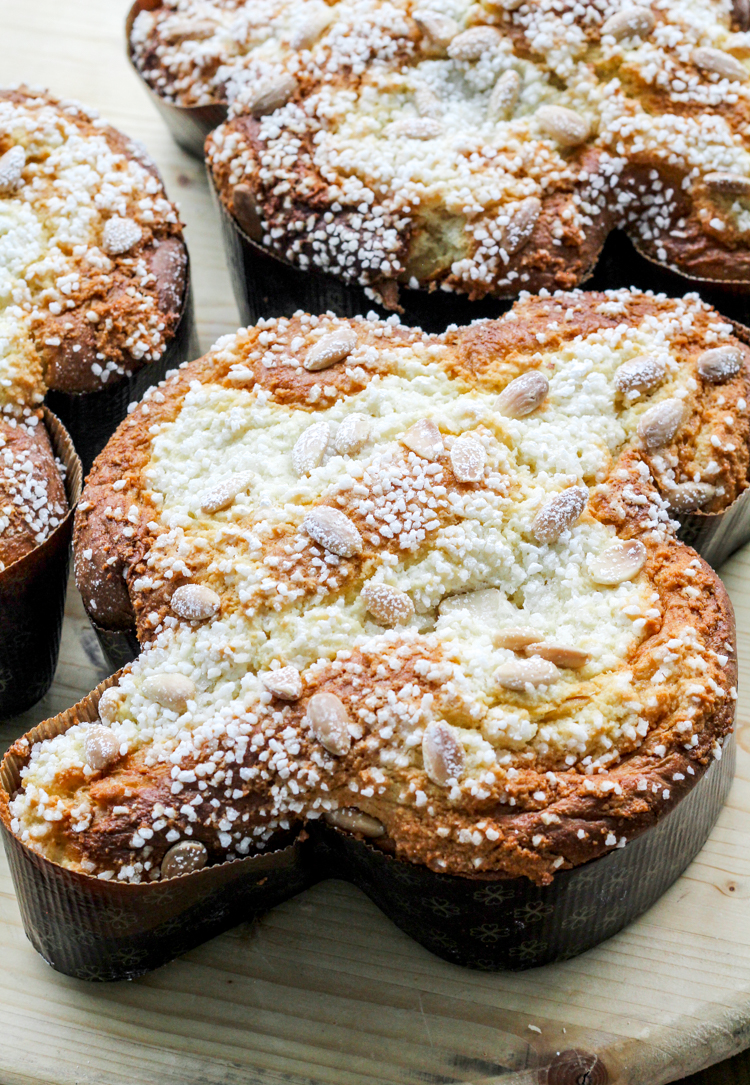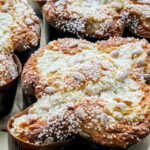Colomba Pasquale- Italian Easter Dove Bread, is an Italian sweet yeast bread that is traditional for Easter. The rich egg and butter dough is shaped into a dove, and is perfect for breakfast, or as a dessert.

You’ll find a colomba all over Italy in any market or in bakeries, and it is enjoyed on Easter Sunday. There really isn’t a need to go through all the trouble to bake one for yourself, when there are so many options!
But if you don’t live somewhere that you can find a Colomba Pasquale (Easter dove bread), you could make your own! Maybe you are lucky enough to be able to buy one, but you always dreamed of making a colomba for Easter from scratch! This Italian Easter dove bread recipe is all you need to make one today!
Putting together the dough is a big endeavor, but it is really not that difficult. Like any yeast dough, it takes a bit of time and lots of patience. The yeast just needs to be able to work its magic.
The dove shape may same daunting, but I think it's not that important to have it actually come out looking like a dove. The most important thing is that the sweet yeast bread is nice and fluffy!
If you are interested in trying one of my other Italian Easter recipes, try my Neapolitan Easter Pie, Italian Easter Meat Pie, Italian Easter Cheese Bread, and my Braided Italian Easter Bread.
Originally published April 2022 and updated March 2024
Jump To
- What Is Colomba And What Does It Mean
- What is the history of the Italian Easter dove cake?
- Why the dove shape?
- 💖Why you'll love my Italian Easter cake!
- 🛒 What ingredients are in an Italian Easter Colomba?
- Equipment you need to make this recipe
- How to make an Italian dove bread (Colomba di Pasqua)? (full directions in recipe below)
- Can I make an Easter colomba by hand?
- What is used as a filling in an Italian colomba Easter bread?
- ☑️ Lora's Expert Tips
- 📃Variations/substitutions for this Colomba di Pasqua:
- 🫙 Leftover and Storing of this Easter Bread
- What to serve with Colomba Pasquale?
- Can I make Italian Easter cake in loaf pans?
- Can you freeze an Italian Easter dove bread?
- FAQ'S
- Some other yeast based doughs to enjoy:
- Colomba Pasquale Recipe- Italian Easter Dove Bread
What Is Colomba And What Does It Mean
Colomba, which translates to "dove" in Italian, refers to a traditional Italian Easter cake shaped like a dove. This sweet bread is typically made with an egg and butter dough, flavored with fragrant orange zest, and studded with candied orange peel or dried fruit.
Colomba is a symbol of peace and renewal, representing the resurrection and new beginnings celebrated during the Easter season in Italy.
What is the history of the Italian Easter dove cake?
The Italian Easter Dove Bread is a holiday with a long history dating back to 572 A.D. The most famous tale, however, comes from Lombardy in Italy, where the Lombardians defeated Holy Roman Emperor Barbarossa in battle.
Two doves (symbolizing the Holy Ghost) reportedly appeared over the battleground as a sign of divine protection.
Colomba Pasquale, which means Easter Dove, became very popular in Italy, until it came to be regarded as the unofficial national Easter bread.
Why the dove shape?
The dove shape of Colomba Pasquale is steeped in legend and tradition. Dating back to the 6th century, one of the oldest tales recounts King Alboin's takeover of the castle of Pavia, where he was presented with a dove-shaped sweet bread as a symbol of peace upon the castle's surrender.
💖Why you'll love my Italian Easter cake!
- Delightful Sweetness: This bread is a delightful combination of sweet and soft textures, making it a perfect indulgence for any holiday celebration.
- Fragrant Orange Zest and Dried Fruit: Infused with fragrant orange zest and dotted with dried fruit, each bite bursts with citrusy aroma and juicy sweetness, adding depth of flavor to every slice.
- Traditional Italian Recipe: Rooted in Italian culinary tradition, this Colomba bread is a symbol of Easter festivities, embodying centuries-old baking techniques and authentic flavors.
- Topped with Almond Flour, Pearl Sugar, and Almonds: The bread is adorned with almond flour, pearl sugar, and whole almonds, not only adding a beautiful finishing touch but also enhancing the overall flavor with their nutty sweetness.
- Versatile Serving Options: Whether enjoyed with a cup of coffee or tea for a leisurely breakfast treat, or paired with jams or preserves for added sweetness, this Colomba bread elevates any dining experience with its versatility.
- Perfect for Holiday Gatherings: Its dove shape and festive presentation make it a stunning centerpiece for Easter brunches or gatherings, impressing guests with its artisanal charm and delicious taste.
- Homemade Goodness: Baking this Colomba bread at home fills your kitchen with the irresistible aroma of freshly baked bread, offering not only a delightful treat for your taste buds but also a sense of pride in creating a homemade masterpiece.

🛒 What ingredients are in an Italian Easter Colomba?
- Here is all you need to make this delicious yeast bread (that is almost like a cake!):
- Starter:
- Yeast: Activates the fermentation process, allowing the dough to rise and develop flavor.
- Milk: Provides moisture and richness to the dough, contributing to its texture and tenderness.
- All-purpose flour: Serves as the base of the starter, providing structure and stability.
- Sugar: Feeds the yeast and adds sweetness to the dough, enhancing its flavor.
- Dough:
- All-purpose flour: Forms the bulk of the dough, providing structure and texture.
- Eggs and Egg Yolk: Add richness, flavor, and color to the dough, as well as helping to bind the ingredients together.
- Salt: Enhances the flavor of the dough and regulates yeast activity.
- Fiori di Sicilia or Vanilla and Orange Extract: Infuses the dough with floral and citrusy notes, enhancing its aroma and flavor.
- Orange Zest: Adds citrusy aroma and flavor to the dough, providing a refreshing contrast.
- Unsalted Butter: Contributes to the richness and tenderness of the dough, as well as adding flavor and moisture.
- Dried Fruit (Raisins and Candied Orange Peel): Incorporates pockets of sweetness and chewy texture throughout the dough, adding flavor and visual interest.
- Glaze and Toppings:
- Egg Whites: Create a shiny, golden-brown crust on the bread when baked.
- Almond Flour: Adds a nutty flavor and texture to the topping, enhancing its overall taste and appearance.
- Sugar: Provides sweetness and helps to caramelize the topping during baking.
- Pearl Sugar or Coarse Sugar: Decorates the bread's surface, adding a crunchy texture and visual appeal.
- Whole or Sliced Almonds: Decorates the bread and adds a nutty flavor and crunch to each bite.
Equipment you need to make this recipe
- Mixing Bowl: For combining and kneading the dough.
- Measuring cups and Spoons: For accurately measuring ingredients.
- Stand Mixer or Hand Mixer: To mix and knead the dough efficiently.
- Dough Hook Attachment (if using a stand mixer): For kneading the dough until smooth and elastic.
- Mixing Spoon or Spatula: For stirring and mixing ingredients.
- Zester or Grater: For obtaining orange zest for flavoring the dough.
- Baking Pan: A dove-shaped Colomba mold or a round cake pan for baking the bread.
- Pastry Brush: For applying glaze to the bread before baking.
How to make an Italian dove bread (Colomba di Pasqua)? (full directions in recipe below)
The dough takes a little bit of work, but it's mostly the patience to let it rise.
The first step is to make the starter. It's easy to put together and needs to rest 6 hours (or even overnight). I forgot to take a photo of the starter.
If your bowl isn't big enough, you may find this the next day. And it's fine, just a little messy. The next day, the rest of the yeast, flour, when the butter and rest of flour and ingredients gets added in.
When we made it this particular time, we should have let it rise in a bigger bowl. Because it really rose!
Once it was ready, it was time to add in the candied citrus and let it rise again.

Mix it all in (we did it by hand on a clean counter).

Using disposable kitchen gloves really helps to deal with the super sticky dough. We tripled the recipe so we would have extra to give to our friends.

Layer on the second part of the dough and then it's time to brush on the almond flour sugar glaze (it's like a sticky paste). Let it rise again and then it's ready to bake!

Sprinkle on the pretty pearl sugar.

📃 NOTE: Recipe card with detailed instructions are below! Print it out for later!
Can I make an Easter colomba by hand?
Yes, you could make the dough by hand. But it is a really sticky dough and it does take a lot of kneading, which is easier to do with the dough hook attachment on a stand mixer. You may already be a yeast dough expert, and can handle all the kneading by hand (it's a good arm workout!).

What is used as a filling in an Italian colomba Easter bread?
An Easter colomba typically is filled with candied citrus or even raisins, or both. Italy has chocolate versions, where they are filled with chocolate chips. There are even chocolate covered colomba's. If you are chocolate lover, add some chocolate chips, it’s up to you!
☑️ Lora's Expert Tips
- Making the Starter: Ensure the milk is warm but not too hot to avoid killing the yeast. Letting the starter rest overnight allows for optimal fermentation and flavor development.
- Making the Dough: When mixing the dough in the stand mixer, gradually add the ingredients to ensure thorough incorporation. Be patient during the mixing process to develop the dough's elasticity and texture.
- Adding the Butter: Slowly incorporate the butter into the dough to prevent it from becoming greasy. Knead the dough until it is smooth, satiny, and no longer sticky to the touch.
- Mixing in Candied Fruit: Use kitchen gloves when mixing in the candied fruit to prevent sticking. Ensure the fruit is evenly distributed throughout the dough for consistent flavor in every bite.
- Letting the Dough Rise: Find a warm, draft-free spot for the dough to rise, as this encourages yeast activity and promotes proper fermentation. Keep an eye on the dough to ensure it doubles in volume before proceeding.
- Shaping the Dough: Take care when shaping the dough into logs and placing them in the mold to create the desired dove shape. Gently manipulate the dough to fill any gaps and ensure even rising during baking.
- Almond Sugar Glaze: Apply the almond sugar glaze just before baking to ensure a shiny, golden-brown crust. Be gentle when brushing on the glaze to avoid deflating the dough.
- Baking: Monitor the bread closely while baking and adjust the oven temperature if necessary to prevent over-browning. Tent the bread with aluminum foil if the top is browning too quickly.
- Cooling and Serving: Allow the bread to cool completely on a rack before slicing and serving. This allows the flavors to fully develop and ensures a moist, tender crumb in each slice. Enjoy your homemade Colomba Pasquale! 🕊️
📃Variations/substitutions for this Colomba di Pasqua:
- Fiori di Sicilia Substitute: If you don't have Fiori di Sicilia on hand, you can easily substitute it with a combination of 2 teaspoons of vanilla extract and 1/2 teaspoon of orange extract. This will still provide a similar citrusy and floral flavor profile to your bread.
- Dried Fruit Variation: Feel free to change up the dried fruit in the recipe according to your preference. You can use raisins, currants, chopped apricots, or any other dried fruit you enjoy. You can even mix different types of dried fruit for added variety and flavor complexity.
- Chocolate Chip Addition: For a more indulgent twist on traditional Colomba di Pasqua, consider adding chocolate chips to the dough. The combination of rich chocolate and citrusy flavors creates a delightful contrast that will surely satisfy any chocolate lover's cravings.
- Coarse Sugar Substitute: If you don't have pearl sugar on hand for the topping, you can use coarse sugar as a substitute. Coarse sugar will still provide a crunchy texture and sweet flavor to the bread's surface, creating a beautiful golden crust when baked.
🫙 Leftover and Storing of this Easter Bread
- Storage: Store any leftover Colomba Pasquale in an airtight container or resealable plastic bag to maintain its freshness. Make sure to wrap it tightly to prevent it from drying out.
- Refrigeration: Colomba Pasquale can be stored in the refrigerator for up to 3-4 days. Refrigeration helps to prolong its shelf life and keeps it moist.
- Freezing: If you have a large amount of leftover Colomba Pasquale or want to save it for longer, you can freeze it. Wrap the bread tightly in plastic wrap and then aluminum foil before placing it in the freezer. It can be frozen for up to 1-2 months.
- Thawing: When ready to enjoy your frozen Colomba Pasquale, remove it from the freezer and let it thaw in the refrigerator overnight. Once thawed, you can reheat individual slices in the microwave or oven for a few seconds to restore their freshness.
- Reheating: To reheat leftover Colomba Pasquale, you can warm it in the oven at a low temperature (around 300°F or 150°C) for a few minutes until it's heated through. This will help to revive its texture and flavors.
What to serve with Colomba Pasquale?
Colomba Pasquale, with its sweet and citrusy flavors, pairs wonderfully with a variety of accompaniments. Here are some delicious serving suggestions:
- Fresh Berries: Serve sliced Colomba Pasquale with a side of fresh berries such as strawberries, raspberries, and blueberries. The tartness of the berries complements the sweetness of the bread, creating a delightful contrast of flavors.
- Whipped Cream: Offer a dollop of freshly whipped cream alongside Colomba Pasquale. The light and airy texture of the whipped cream adds a creamy element that enhances the indulgent nature of the bread.
- Mascarpone Cheese: Spread a generous layer of mascarpone cheese on slices of Colomba Pasquale. The creamy and slightly tangy flavor of mascarpone cheese complements the citrusy notes of the bread, creating a luxurious and decadent treat.
- Italian Dessert Wine: Pair Colomba Pasquale with a glass of Italian dessert wine such as Moscato d'Asti or Vin Santo. The sweet and fruity characteristics of these wines complement the flavors of the bread, making for a delightful and elegant dessert pairing.
- Coffee or Espresso: Enjoy Colomba Pasquale with a freshly brewed cup of coffee or espresso. The rich and robust flavors of the coffee enhance the sweetness of the bread, creating a perfect balance of flavors.
Can I make Italian Easter cake in loaf pans?
Yes, if you don't have the dove paper molds, you could divide the dough into loaf pans. Or make your own dove design with aluminum foil.
Can you freeze an Italian Easter dove bread?
Yes, once it has cooled down completely, slice into slices or big chunks. Wrap in plastic wrap and place in zipped lock freezer bag. Stays fresh for up to 2 months.
FAQ'S
Easter Panettone is called Colomba Pasquale in Italian. It's a traditional sweet bread, similar to panettone but shaped like a dove and decorated with pearl sugar and almonds.
Easter colomba is a traditional Italian sweet yeast bread that is served during Easter. It's shaped into the form of a dove and topped with pearl sugar, almonds, and dried fruit. The dough is made using butter, eggs, flour, sugar, salt and Fiori di Sicilia or orange extract.
Easter bread is made with a rich egg and butter dough, plus fragrant orange zest, dried fruit, sugar and Fiori di Sicilia.
Panettone is a traditional Italian sweet bread, while Colomba Pasquale is an Italian Easter version of Panettone. It's shaped like a dove and decorated with pearl sugar and almonds. Both are made using butter, eggs, flour, sugar, salt and Fiori di Sicilia or orange extract.
Colomba Pasquale can be served for breakfast, as a snack or even as a dessert. It's delicious with some jams or preserves, and it pairs well with coffee or tea. You can also add some whipped cream to the top for a sweet and creamy treat!
In Italy, the day after Easter is called Pasquetta. It's known as the "Little Easter" and is usually celebrated with a picnic or outdoor gathering. Traditionally, people eat special dishes made from leftovers from Easter lunch, such as frittata or pasta al forno.
On Pasqua (Easter Sunday), Italians typically celebrate with a big family meal, where they enjoy traditional Easter dishes such as lamb or baked ham. Following the meal, people go to church for a special mass in celebration of the resurrection of Jesus Christ.
The traditional Italian Easter bread, Colomba Pasquale, is shaped like a dove as a symbol of peace. This shape also represents the Holy Spirit and the resurrection of Jesus Christ. The sweet almond-scented dough is traditionally topped with pearl sugar and almonds to create the dove shape. It's said that eating this bread brings luck and peace to the household.
Fiori di Sicilia is an Italian flavor extract made of orange blossom, vanilla, lemon and other aromatics. It's commonly used in baking recipes such as Easter Panettone or Colomba Pasquale to give them their signature aroma and flavor. It can be found at specialty stores or online.
The history of colomba di Pasqua dates back to the Middle Ages, when it was first mentioned in a text from the Italian city of Como. The bread was originally made with a sourdough starter and shaped into a ring to symbolize the crown of thorns worn by Jesus Christ. Over time, the recipe evolved to incorporate butter and eggs, and the shape changed to a dove. Today, Colomba Pasquale is enjoyed all over Italy as part of the Easter celebration.
There are many variations of colomba di Pasqua that people enjoy throughout Italy. Some popular versions include adding flavors such as chocolate chips, pistachios or candied fruits. Some recipes also call for adding different extracts such as rum or almond to the dough. Also, some people like to top the bread with a simple glaze or drizzle of icing for an extra sweet touch.
Italians eat Colomba for Easter as it is a traditional symbol of the holiday, representing peace, renewal, and the spirit of Easter.
Panettone is a tall, cylindrical sweet bread typically enjoyed during Christmas and New Year's celebrations in Italy. It is studded with candied fruits and raisins, giving it a rich and fruity flavor. Colomba, on the other hand, is a dove-shaped sweet bread specifically made for Easter, flavored with candied orange peel and sometimes almonds, symbolizing peace and renewal.
Some other yeast based doughs to enjoy:
- Crescia al Formaggio-Italian Easter Cheese Bread
- Chocolate Babka
- Crusty No-Knead Italian Bread
- Casatiello
recipe slightly adapted from Bob's Red Mill
Just a quick request: if you enjoyed Easter Colomba as much as we did, would you kindly leave me a 5-star rating and a short (or long!)comment–the ratings are what helps get my recipes and hard work discovered, so I can keep leaving you more delish recipes!
Your comments mean the world to me….and I really SMILE when I read them. Thank you so much! XX
Colomba Pasquale Recipe- Italian Easter Dove Bread
Ingredients
- Starter:
- 1 Tablespoon yeast
- 1 cup lukewarm milk about 110F degrees
- ½ cup all-purpose flour
- 1 tablespoon sugar
- Dough:
- 2 ½ cups all-purpose flour
- ½ Tablespoon yeast
- 2 eggs
- 1 egg yolk
- ⅓ cup sugar
- ½ teaspoon salt
- ½ teaspoon Fiori di Sicilia or 2 teaspoons vanilla extract + 1/2 teaspoon orange extract
- zest of 1 orange
- 8 ounces unsalted butter softened
- 1 cup dried fruit I used homemade candied orange peel, but you could use raisins
- Glaze and Toppings:
- 2 egg whites
- ⅓ cup almond flour
- 1/4 cup sugar
- 4 Tablespoons pearl sugar substitute: coarse sugar
- 2 to 3 Tablespoons whole or sliced almonds
Instructions
- Making the starter:
- Sprinkle the yeast on the warm milk and let it sit for 5 minutes. Whisk in the flour and sugar, cover with plastic wrap and let it rest overnight (or for at least 6 hours) at room temperature, or until it triples in volume.
- Making the dough (FIRST RISING OF THE DOUGH):
- On the next day: in the bowl of a stand mixer with a dough hook attached, add in the starter, the rest of the yeast, and 2 cups of flour. Mix on medium-low speed for 5 minutes to combine.
- Add in sugar and eggs: add the sugar, eggs, last ½ cup of flour, salt, and Fiori di Sicilia (or extracts) into the bowl. On medium speed, mix for about 15 minutes. Add in more flour in very small amounts, if it’s needed, to combine the dough.
- Add in the butter: as soon as the dough is elastic, start to add the butter in slowly. Knead on medium speed for 10 minutes, until the dough is smooth and satiny, and is not sticky to touch (the dough should be elastic and bounce back when you touch it).
- Mix in candied fruit: dump the dough out onto a clean counter, or work surface. Add in the candied fruit (or chocolate) and mix to combine. Using kitchen gloves helps to work this sticky dough.
- Let dough rise: Place the dough in an oiled bowl, cover and leave in a warm place until doubled in volume – for 3-4 hours.
- SECOND RISING OF THE DOUGH
- Punch down the dough: transfer the dough to a lightly floured clean counter or work area, and punch it down. Separate the dough into two equal portions, with one portion a little longer than the other. Form the divided dough sections into logs.
- Prep your paper mold or baking tin: spray a dove bread paper mold with baking spray and place the dough logs into the mold. Start with the first log that goes on bottom of mold to the edges of the wings.
- Second portion of dough: place the second dough log on top of the first log, laying it down from the head to the tail. Gently push the dough to fill into any gaps of the mold.
- Loosely cover the dough: Loosely cover with a clean kitchen towel and let it rest at room temperature for 45 to 60 minutes (it could take 2 hours), or until doubled in size.
- Preheat oven to 375F degrees.
- Make the almond sugar glaze: in a clean mixing bowl, beat the egg whites until foamy and whisk in the almond flour and sugar until you have a white paste-like glaze.
- Brush on the almond sugar glaze: as soon as the bread is ready to bake, use a brush to carefully add on the almond sugar glaze. Brush it on softly so you do not deflate the bread. Sprinkle on some pearl sugar and decorate with the almonds.
- Bake the colomba: bake on 375°F for 15 minutes, then lower the heat to 350°F and bake for an additional 20 to 30 minutes. If the top is browning too much, carefully tent with aluminum paper for the last 10 minutes of baking. Bake the bread until it is a nice golden brown, or unti an instant-read thermometer inserted into the center reads 190°F.
- Let the bread cool down: when it’s ready, carefully remove the bread from the oven and place on a rack to cool down. Slice into portions and enjoy!
Nutrition Disclaimer
Please keep in mind that the nutritional information presented below is an approximation and may vary depending on the exact ingredients used.





Hannah says
This Easter Bread is amazing ! My kids loved it thank you.